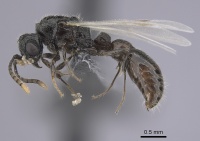Parasyscia wittmeri
| Parasyscia wittmeri | |
|---|---|

| |
| Scientific classification | |
| Kingdom: | Animalia |
| Phylum: | Arthropoda |
| Class: | Insecta |
| Order: | Hymenoptera |
| Family: | Formicidae |
| Subfamily: | Dorylinae |
| Genus: | Parasyscia |
| Species: | P. wittmeri |
| Binomial name | |
| Parasyscia wittmeri (Collingwood, 1985) | |
This species has been found in soil under a stone in grazed scrubby pasture (Collingwood 1985).
Identification
Sharaf et al. (2018) - Parasyscia wittmeri can be diagnosed by the combination of the following characters: eyes distinctly small with five ommatidia in longest row; petiole appears oval in dorsal view with curved anterior and posterolateral angles; uniform yellow or red-yellow.
This species can be separated from the only other Parasyscia known from the Arabian region by the following couplet:
- Eyes small with five ommatidia in the longest row (EI 11–18); petiole nearly oval in dorsal view with rounded anterior and posterolateral angles . . . . . Parasyscia wittmeri
- Eyes larger with 11–12 ommatidia in the longest row (EI 15–30); petiole clearly trapezoidal in dorsal view with acute anterior and posterolateral angles . . . . . Parasyscia rifati
Keys including this Species
Distribution
Latitudinal Distribution Pattern
Latitudinal Range: 18.201583° to 13.6°.
| North Temperate |
North Subtropical |
Tropical | South Subtropical |
South Temperate |
- Source: AntMaps
Distribution based on Regional Taxon Lists
Afrotropical Region: Saudi Arabia (type locality).
Distribution based on AntMaps
Distribution based on AntWeb specimens
Check data from AntWeb
Countries Occupied
| Number of countries occupied by this species based on AntWiki Regional Taxon Lists. In general, fewer countries occupied indicates a narrower range, while more countries indicates a more widespread species. |

|
Estimated Abundance
| Relative abundance based on number of AntMaps records per species (this species within the purple bar). Fewer records (to the left) indicates a less abundant/encountered species while more records (to the right) indicates more abundant/encountered species. |

|
Biology
Castes
Images from AntWeb

| |
| Male (alate). Specimen code casent0263903. Photographer Will Ericson, uploaded by California Academy of Sciences. | Owned by CAS, San Francisco, CA, USA. |
Nomenclature
The following information is derived from Barry Bolton's Online Catalogue of the Ants of the World.
- wittmeri. Cerapachys wittmeri Collingwood, 1985: 237, fig. 8 (w.) SAUDI ARABIA.
- Type-material: holotype worker, 11 paratype workers.
- Type-locality: holotype Saudi Arabia: Al Kola, semi cultivated area, 10.iv.1983 (C.A. Collingwood); paratypes with same data.
- Type-depository: WMLC.
- [Note: in the original description Collingwood states that type-material is in BMNH and NHMB; however, the only known type-material is in WMLC.]
- Combination in Parasyscia: Borowiec, M.L. 2016: 205.
- Status as species: Bolton, 1995b: 145; Collingwood & Agosti, 1996: 312; Borowiec, L. 2014: 62; Sharaf, Akbar & Aldawood, 2018: 219 (redescription).
- Distribution: Saudi Arabia.
Unless otherwise noted the text for the remainder of this section is reported from the publication that includes the original description.
Description
Worker
Sharaf et al. (2018) - BL 1.75–3.40; EL 0.05–0.10; HL 0.45–0.87; HW 0.45–0.57; PH 0.27–0.45; PL 0.25–0.35; PRW 0.30–0.42; PW 0.25–0.42; SL 0.27–0.40; TL 0.35–0.40; WL 0.62–0.90. Indices: CI 63–100; EI 11–18; SI 53–74 (n = 8).
Head. Distinctly longer than broad in full-face view, with straight posterior margin and feebly convex sides; antennae with 11 segments; scapes when laid back from their insertions surpass posterior margin of eyes in full-face view; funicular segments 2–8 distinctly broader than long; preapical segment little longer broad; apical funicular segment swollen forming a distinct club nearly as long as rest of funicular segments except first segment; eyes small with five ommatidia in longest row. Mesosoma. Promesonotal and metanotal sutures absent; posterior margin of propodeum feebly concave in dorsal view. Petiole. In dorsal view broader posteriorly than anteriorly. Sculpture. Body surface punctate. Pilosity. Pale suberect hairs abundant over entire body surfaces. Colour. Uniformly yellow or red-yellow.
References
- Borowiec, M.L. 2016. Generic revision of the ant subfamily Dorylinae (Hymenoptera, Formicidae). ZooKeys 608: 1-280 (doi: 10.3897/zookeys.608.9427).
- Bolton, B. 1995b. A new general catalogue of the ants of the world. Cambridge, Mass.: Harvard University Press, 504 pp. (page 145, catalogue)
- Borowiec, M.L. 2019. Convergent evolution of the army ant syndrome and congruence in big-data phylogenetics. Systematic Biology 68, 642–656 (doi:10.1093/sysbio/syy088).
- Chen, Z., Liang, C., Du, C. 2022. Revision of Chinese species of the ant genus Parasyscia Emery, 1882 (Hymenoptera: Formicidae: Dorylinae). Zootaxa 5196(3), 301–330 (doi:10.11646/zootaxa.5196.3.1).
- Collingwood, C. A. 1985. Hymenoptera: Fam. Formicidae of Saudi Arabia. Fauna Saudi Arab. 7: 230-302 (page 237, fig. 8 worker described)
- Sharaf, M.R., Akbar, S.A., Aldawood, A.S. 2018. Review of the Arabian rare ant genus Parasyscia Emery, 1882 (Hymenoptera: Formicidae) with description of a new species from the Asir Mountains, Saudi Arabia. African Entomology 26(1): 215–223 (doi:10.4001/003.026.0215).
References based on Global Ant Biodiversity Informatics
- Borowiec L. 2014. Catalogue of ants of Europe, the Mediterranean Basin and adjacent regions (Hymenoptera: Formicidae). Genus (Wroclaw) 25(1-2): 1-340.
- Borowiec M. L. 2016. Generic revision of the ant subfamily Dorylinae (Hymenoptera, Formicidae). ZooKeys 608: 1–280.
- Collingwood C. A. 1985. Hymenoptera: Fam. Formicidae of Saudi Arabia. Fauna of Saudi Arabia 7: 230-302.
- Collingwood, C. A. and D. Agosti. 1996. Formicidae (Insects: Hymenoptera) of Saudi Arabia (Part 2) Fauna of Saudi Arabia 15: 300-385.
- Collingwood, C. A. "Hymenoptera: Fam. Formicidae of Saudi Arabia." Fauna of Saudi Arabia 7 (1985): 230-302.

